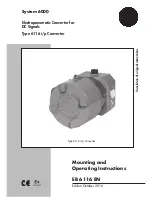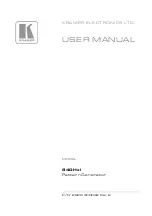
25
HDE-8C-QAM
Instruction Manual
1
2
Data Rate:
allows the user to select the audio encoding bitrate in Kbps (kilobits per second). The range is 96 to 448
kbps. The factory default value is 192 kbps that supports Audio Coding Mode 2/0:L, R.
NOTE:
See Dolby Encoding guidelines for additional information.
Delay:
allows the user to adjust the audio delay (-300 to 300 ms) to correct for input video/audio sync mismatch.
Sample Rate:
indicates the input sampling rate of the encoder. The HDE-8C-QAM supports 48 kHz sampling rate.
Audio Coding Mode:
also referred to as Channel mode. Indicates the number of main audio channels within the
encoded bitstream and also indicates the channel format. The unit supports 2/0:L,R= audio is a dual channel (Left &
Right).
Dialog Normalization:
behaves as an Audio Automatic Gain Control (AGC) or Dynamic Range Control (DRC). It has the
ability to take different incoming audio levels and normalize them. The ability of the Dialog Normalization depends
on the configuration of the Dynamic Range Control. The HDE-8C-QAM allows you to adjust the normalization from -1
to -31 dB. The typical value is -27 dB. This is based on the standard film audio formats which normally are between
-25 and -31 dB.
Dolby Surround Mode:
indicates if the audio is two-channel Dolby or not. Possible options are:
Unspecified: indicates the decoder must determine the audio format by itself.
Disabled: indicates the audio is not encoded in surround mode.
Enabled: indicates the audio is encoded in surround mode.
Line Mode:
allows the user to select the type of Dynamic Range Compression to be applied to signals that will be used
as direct audio feeds into a TV tuner or other receive devices. The factory default value is “None”.
RF Mode:
allows the user to select the type of Dynamic Range Compression to be applied to signals that will be used
for retransmission on an RF carrier, and then fed into TV tuner or other receive devices at the end of the line. The
factory default value is “None”.
Possible options for and are:
i)
None:
no dynamic range controls have been assigned.
ii)
Film Standard
: suitable for movies where the very low-level sounds are not to be amplified due to other
undesirable background noises that may become audible, but rather the peaks and valleys are normalized instead.
It has a null bandwidth of 10 dB (-31 to -21 dB) and can add up to 6 dB of boost for low levels and attenuate
high levels. The setting is used to quiet load shouting and amplifier whispers. See Dolby Encoding guidelines for
additional information.
iii)
Film Light:
is similar to “Film Standard” but with a null bandwidth of 20 dB (-41 to -21 dB) and can add up to 6
dB of boost for low levels and attenuate high levels.
iv)
Music Standard:
suitable for program content that is mainly made up of music where the sound level is to be
normalized (reducing the loudness) to be consistent with other programs. It has a null bandwidth of 10 dB (-31
to-21 dB) and can add up to 12 dB of boost for low levels and attenuate high levels. See Dolby Encoding guidelines
for additional information.
v)
Music Light:
similar to “Music Standard” but with a null bandwidth of 20 dB (-41 to -21 dB) and can add up to 12
dB of boost for low levels and attenuate high levels.
vi)
Speech:
suitable for program content that is mainly made up of speech only and has a null band width of 10 dB (-31
to -21 dB) for average speech and can add up to 15 dB of boost for low levels and attenuate high levels. The setting
is used to quiet load shouting and amplifier whispers. See Dolby Encoding guidelines for additional information.
7
8
3
4
7
8
5
6
Remember to click on the SAVE button to apply the new values/configurations.
Содержание HDE-8C-QAM w/Opt 2
Страница 42: ...42 HDE 8C QAM Instruction Manual NOTES ...
















































